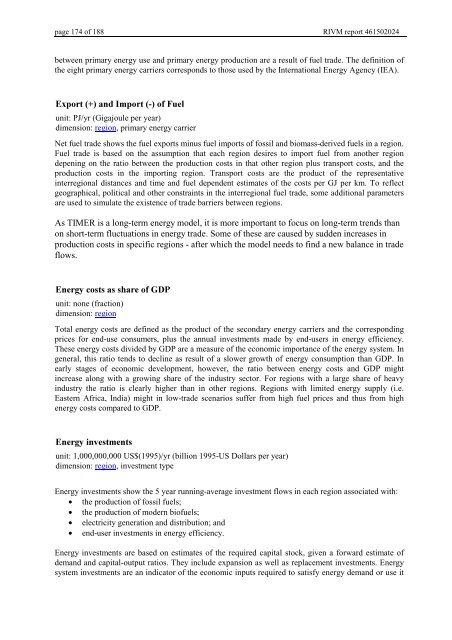Targets IMage Energy Regional (TIMER) Model, Technical ...
Targets IMage Energy Regional (TIMER) Model, Technical ...
Targets IMage Energy Regional (TIMER) Model, Technical ...
You also want an ePaper? Increase the reach of your titles
YUMPU automatically turns print PDFs into web optimized ePapers that Google loves.
page 174 of 188 RIVM report 461502024<br />
between primary energy use and primary energy production are a result of fuel trade. The definition of<br />
the eight primary energy carriers corresponds to those used by the International <strong>Energy</strong> Agency (IEA).<br />
([SRUWDQG,PSRUWRI)XHO<br />
unit: PJ/yr (Gigajoule per year)<br />
dimension: region, primary energy carrier<br />
Net fuel trade shows the fuel exports minus fuel imports of fossil and biomass-derived fuels in a region.<br />
Fuel trade is based on the assumption that each region desires to import fuel from another region<br />
depening on the ratio between the production costs in that other region plus transport costs, and the<br />
production costs in the importing region. Transport costs are the product of the representative<br />
interregional distances and time and fuel dependent estimates of the costs per GJ per km. To reflect<br />
geographical, political and other constraints in the interregional fuel trade, some additional parameters<br />
are used to simulate the existence of trade barriers between regions.<br />
As <strong>TIMER</strong> is a long-term energy model, it is more important to focus on long-term trends than<br />
on short-term fluctuations in energy trade. Some of these are caused by sudden increases in<br />
production costs in specific regions - after which the model needs to find a new balance in trade<br />
flows.<br />
(QHUJ\FRVWVDVVKDUHRI*'3<br />
unit: none (fraction)<br />
dimension: region<br />
Total energy costs are defined as the product of the secondary energy carriers and the corresponding<br />
prices for end-use consumers, plus the annual investments made by end-users in energy efficiency.<br />
These energy costs divided by GDP are a measure of the economic importance of the energy system. In<br />
general, this ratio tends to decline as result of a slower growth of energy consumption than GDP. In<br />
early stages of economic development, however, the ratio between energy costs and GDP might<br />
increase along with a growing share of the industry sector. For regions with a large share of heavy<br />
industry the ratio is clearly higher than in other regions. Regions with limited energy supply (i.e.<br />
Eastern Africa, India) might in low-trade scenarios suffer from high fuel prices and thus from high<br />
energy costs compared to GDP.<br />
(QHUJ\LQYHVWPHQWV<br />
unit: 1,000,000,000 US$(1995)/yr (billion 1995-US Dollars per year)<br />
dimension: region, investment type<br />
<strong>Energy</strong> investments show the 5 year running-average investment flows in each region associated with:<br />
• the production of fossil fuels;<br />
• the production of modern biofuels;<br />
• electricity generation and distribution; and<br />
• end-user investments in energy efficiency.<br />
<strong>Energy</strong> investments are based on estimates of the required capital stock, given a forward estimate of<br />
demand and capital-output ratios. They include expansion as well as replacement investments. <strong>Energy</strong><br />
system investments are an indicator of the economic inputs required to satisfy energy demand or use it
















